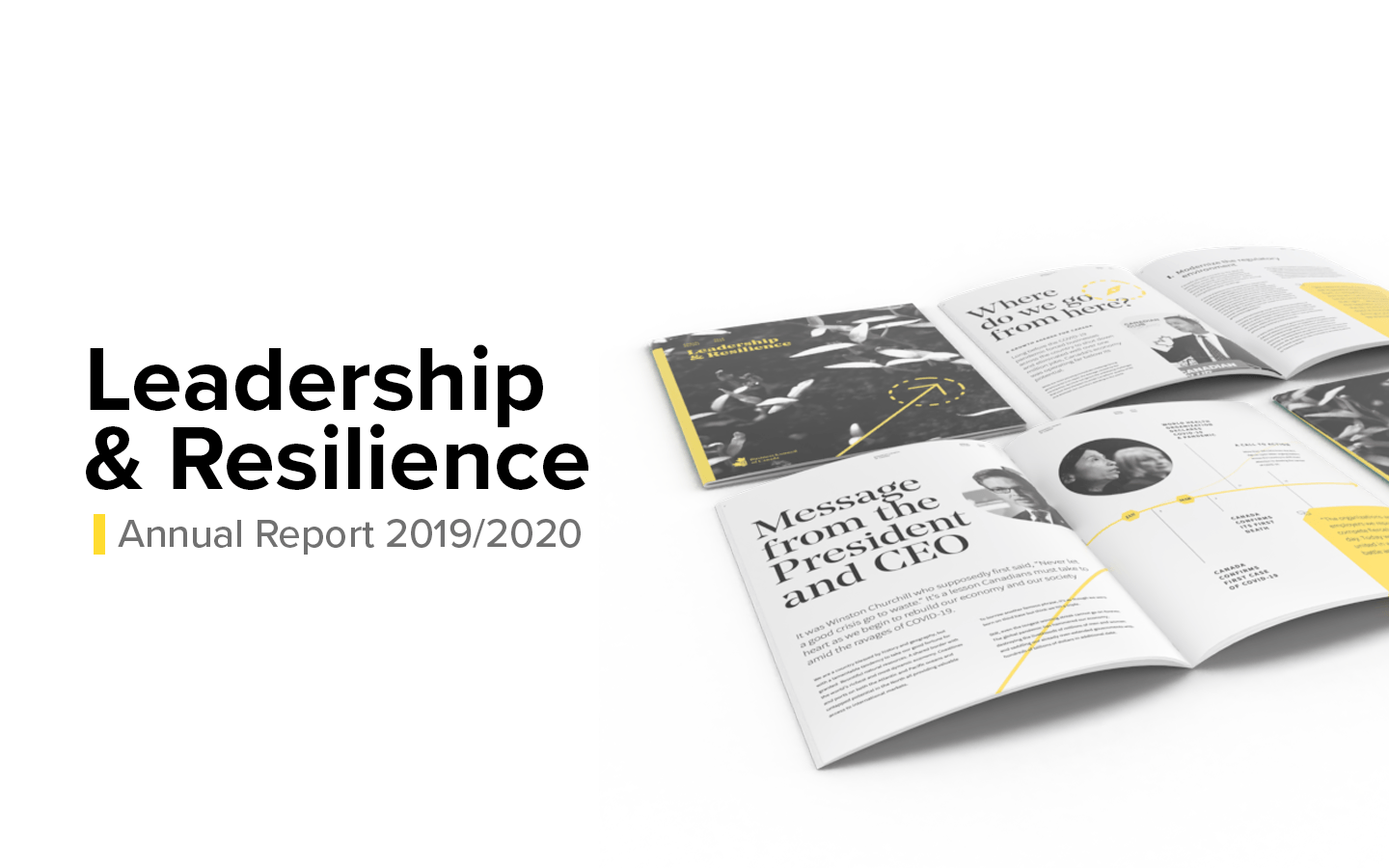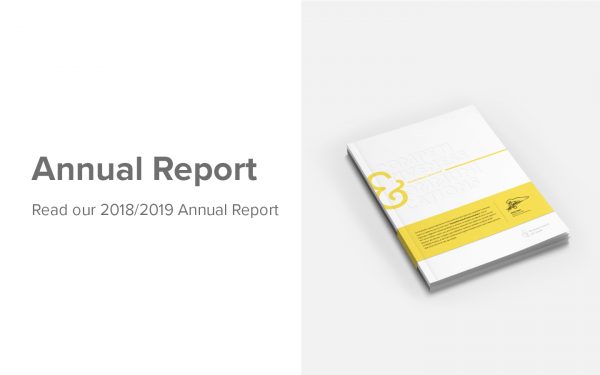Leadership & Resilience
2019/2020 Annual Report
Message from the Chair

Member companies of the Business Council of Canada and their employees are among this country’s most generous supporters of charitable causes and community services. So when the COVID-19 pandemic struck with full force early in 2020, it was no surprise that many of Canada’s leading businesses were quick to step up to support the response.
Companies in every sector, in every part of the country, moved quickly to help slow the spread of the coronavirus, save lives, and contribute to the economic recovery needed in the wake of this health emergency.
Airlines rejigged flight schedules and dispatched planes and air crews to bring home Canadians who found themselves stranded abroad by travel restrictions.
Manufacturers retooled factories to produce ventilators, disinfecting solutions, personal protective equipment and other urgently needed medical gear.
Banks allowed financially squeezed homeowners to defer their mortgage payments and introduced flexible repayment options for other forms of debt.
Insurers slashed auto premiums and reduced rates on other types of policies so customers would not be required to pay for services they were unable to use during the lockdown.
Telecommunication providers donated free mobile phones to isolated seniors, waived fees for long-distance calls, and removed internet data-usage caps to make it easier for people to work and learn from home and stay connected.
Essential services like grocery store retailers, energy suppliers and trucking companies worked in the midst of the lockdown to keep food and supplies on the shelves, and heat and electricity flowing to our homes.
Information technology companies created new software tools to assist researchers and healthcare workers in their quest to better understand the virus, develop treatments for it and work toward a vaccine.
Hotels provided free emergency accommodation for front-line health workers, while accounting firms offered to prepare their tax returns at no charge.
And that is just a small sample of the contributions made. Companies in a wide range of industries also donated money and essential supplies to health care providers, food banks, mental health support initiatives, women’s shelters, the Canadian Red Cross, and United Way and Centraide organizations and others across the country.
In April, as Canadians and Canadian companies moved into high gear to fight the pandemic, some drew comparisons between the collective response of the business community to COVID-19 and the industrial war effort that sustained the nation and Canada’s troops during the Second World War.
When war broke out in 1939, no one had any idea how long it would last. The nature of the threat today is very different, but the outlook is similarly uncertain.
Potential treatments for COVID-19 are evolving with unprecedented speed, as are efforts to develop a vaccine. However, until a vaccine is widely available, we will have to learn to live with the coronavirus, taking steps to reduce transmission to keep people and communities safe. As business leaders, we are grateful for Canada’s leadership in managing the pandemic and for the collaboration with provincial and territorial governments to flatten the curve.
We all hope a solution can be found soon. But regardless of how long it takes, the country’s business leaders will be there for Canadians – working together with governments, social agencies and others to support employees, customers, communities and the country as we come through this challenge together.
Message from the President and CEO

It was Winston Churchill who supposedly first said, “Never let a good crisis go to waste.” It’s a lesson Canadians must take to heart as we begin to rebuild our economy and our society amid the ravages of COVID-19.
We are a country blessed by history and geography, but with a lamentable tendency to take our good fortune for granted. Bountiful natural resources. A shared border with the world’s richest and most dynamic economy. Coastlines and ports on both the Atlantic and Pacific oceans and untapped potential in the North all providing valuable access to international markets.
To borrow another famous phrase, it’s as though we were born on third base but think we hit a triple.
Still, even the longest winning streak cannot go on forever. The global pandemic has hammered our economy, destroying the livelihoods of millions of men and women and saddling our already over-extended governments with hundreds of billions of dollars in additional debt.
All this at a time of rising geopolitical tensions and global economic instability. It has been clear for some time now reliable partners can no longer be counted on and the world is devolving into a more complicated place. It is a world in which we will increasingly be fending for ourselves.
The question is, how can we turn these challenges to our advantage? How can we ensure the crisis in which we find ourselves does not “go to waste”?
We can start by squarely facing up to reality. Long before the pandemic took hold, it was clear that we were living in a much more competitive world – a world in which “good enough” is no longer good enough.
If anything, the damage wrought by COVID-19 will have the effect of sharpening international economic rivalries. Countries around the world are going to be working harder than ever to attract investment and jobs. The competition for capital, talent and ideas is certain to intensify.
To succeed in this new environment, we need to chart, with urgency, a new and more ambitious course for Canada.
We need to harness our considerable strengths – notably our rich natural and human resources – while unleashing our imagination and entrepreneurial spirit.
We need a plan that recognizes our potential and responds to the challenges of the day, ranging from health emergencies to climate change to the impact of digital technology on our workplaces and society.
Much is in our control. It has been more than half a century since Canada last conducted a comprehensive review of its tax system. We are burdened with interprovincial trade barriers, the dismantling of which would, according to the International Monetary Fund, unlock the equivalent of
a four per cent increase in Gross Domestic Product.
We have in many ways landlocked our energy sector, and we continue to rely on aging transportation and port infrastructure. It doesn’t have to be this way.
We need to seize the opportunity to build back better.
The business leaders I represent are committed to making Canada the most attractive place in the world to live, work, invest and grow. Our Task Force on Canada’s Economic Future put forward a plan to strengthen growth, create high-value jobs and ensure that our country achieves its full potential.
But it’s not just about the economy. It’s also about our society. We are witnessing social movement after social movement demanding change – and rightfully so. We need to address longstanding disparities such as systemic racism, gender inequality and insufficient opportunities for Indigenous peoples. We need to address the mental health crisis, which the pandemic and social isolation have exacerbated. And we need to support parents with safe, reliable childcare and a robust education system that can adapt to changing circumstances. All of which benefit from a strong economy. The two go hand in hand.
Canada’s business leaders are ready to work with governments of all stripes, labour, Indigenous communities and other stakeholders to ensure that our country emerges from this crisis ready to lead the world. There is much to do, so let’s get to it.
A COVID-19 timeline

Leadership is put to the test during times of crisis. And the COVID-19 pandemic presented the greatest test most leaders have ever confronted. Faced with an unprecedented health and economic emergency, members of the Business Council of Canada responded with speed, concern and compassion, leading the way for others.
January
January 9, 2020
Canada confirms first case of COVID-19
March
March 9, 2020
Canada confirms its first death
March 11, 2020
World Health Organizations declares COVID-19 a pandemic
March 13 - 27, 2020
Provinces and Territories declare states of emergency
March 15, 2020
A call to action
More than 100 CEOs from the BCC sign an open letter urging leaders across the country to shift their attention to slowing the spread of COVID-19.
March 26+, 2020
Leading by example
Speaking of Business podcast launches a special series focused on how employers are responding to the COVID-19 pandemic. More than 30 CEOs share inspiring stories of leadership and resilience.
Businesses respond to the growing crisis
- providing essential services while keeping employees safe;
- helping repatriate thousands of Canadians;
- adapting to work from home models;
- donating millions of dollars to charities across the country;
- retooling factories to provide much-needed medical equipment.
April
April 6, 2020
Collaborating with others
The BCC joins forces with other associations to support the Canadian Business Resilience Network, helping to support businesses throughout the pandemic. The collaboration includes the Canadian Chamber of Commerce, the Canadian Council for Aboriginal Business, the Canadian Federation of Independent Business and Canadian Manufacturers and Exporters.
April 9, 2020
A focus on mental health
The BCC supports the launch of Wellcan, a Morneau Shepell initiative that offers a free collection of digital resources to support mental health during the pandemic.
April 26, 2020
Advocating for a coordinated response
In an open letter to the Prime Minister and the Premiers, the BCC calls for coordination between all levels of government and a responsible restart of the economy that is guided by four core principles:
- Health and safety must be paramount;
- There needs to be a national common set of guidelines, recognizing that the timelines for resumption of activities may vary by sector and region;
- Employers must have access to adequate supplies of equipment to protect their people; and
- Canada should learn from the experiences of other countries.
... less than 2 weeks later, The Prime Minister and Premiers release a common set of principles for restarting the Canadian economy.
May
May 16, 2020
An urgent need for testing, tracking and tracing
In an op-ed in Maclean’s, Goldy Hyder and Dr Isaac Bogoch highlight the urgent need for a significant increase in COVID-19 testing nationwide.
... A few days later, Ontario Premier Doug Ford announces a commitment to expanded testing in the province.
May 20, 2020
First virtual meeting of the BCC
More than 100 business leaders gather to discuss the way forward. The Honourable Catherine McKenna, Minister of Infrastructure and Communities, and Michael Sabia, new Chair of the Canada Infrastructure Bank, discuss the importance of infrastructure projects as job creators and enablers of long-term economic growth.
In a roundtable discussion, members emphasize that high levels of public confidence and trust will be essential to ensuring a successful economic restart.
June
June 21, 2020
Restoring confidence
The Business Council of Canada spearheads the launch of the POST Promise, a business-led public education campaign that allows companies to demonstrate their commitment to keeping customers and employees safe while we continue to co-exist with COVID-19. The federal government endorses the initiative.
June 23, 2020
Looking ahead to the recovery
In anticipation of an economic “snapshot” in July, the BCC sends a letter to Finance Minister Bill Morneau with recommendations on medium-term initiatives the government should take:
- Continue to expand COVID-19 testing and contact tracing;
- Selectively ease travel restrictions;
- Provide immediate support to Canada’s hard-hit travel, tourism and hospitality sectors;
- Accelerate infrastructure approvals and investments; and
- Help displaced workers transition to new jobs.
June 25, 2020
Meeting with the new Governor of the Bank of Canada
Members gather for a second virtual meeting to hear from Tiff Macklem, new Governor of the Bank of Canada. In a CEO roundtable, discussion revolves around the “heterogeneity” of the economic restart: some sectors are poised to bounce back quickly while others – such as travel and tourism – may struggle for an extended period.
July
July 8, 2020
Finance Minister Bill Morneau delivers an economic snapshot with a projected deficit of $343 billion
“Today’s economic and fiscal snapshot underscores why it’s vital to get the economy moving and growing again... We have succeeded in flattening the curve. We are now in a new phase while we await a vaccine or treatment. We have clear guidance from public health experts on what we as individuals need to do to keep the virus under control. Businesses and individuals can be trusted to restart the economy safely and responsibly.”
Goldy Hyder
Canadian businesses respond
Stepping up

Canadian businesses were quick to step up in the fight against COVID-19.
In industries such as energy, agri-food, telecommunications and transportation, companies that provide essential services to Canadians adopted strict new guidelines to protect the health and safety of front-line workers.
Offices shifted to work-from-home models. When airspace and border restrictions left thousands of Canadians stranded abroad, telecom companies and airlines worked with federal officials to get messages through to travellers and bring them home safely.
While layoffs were unavoidable in some cases, many of Canada’s leading employers made special efforts to keep employees on the payroll regardless of whether there was work to do or customers to serve. And when the economy began to reopen, businesses took the lead in implementing new protocols and redesigning workspaces to ensure the health and safety of their employees.
Meanwhile, companies answered the call to ensure that front-line health workers had sufficient supplies of personal protective gear and life-saving medical equipment.
To mitigate the economic impacts of the health emergency, Canada’s leading companies donated hundreds of millions of dollars to food banks and other charities to help those in need, as well as investing millions more toward initiatives supporting small businesses and communities.
“From the very beginning of this outbreak, our priority has been the safety and health of all Canadians. We’re partner- ing with Canadian industry and business so we can act fast to ensure our health care providers have the products and supplies they need to help Canadians. Together, we are mobilizing all of Canada to fight the spread of the virus.”
The Right Honourable Justin Trudeau, Prime Minister of Canada
Finally, some of the country’s most well-known brands rallied behind cultural programs to celebrate local artists, the achievements of young people, and the resiliency of Canadians.
The message delivered by members of the Business Council of Canada was clear: we’ll get through this together.
“This mass mobilization of govern- ment, business, communities and private citizens to slow the spread of COVID-19 represents one of the largest and most ambitious efforts ever undertaken.”
The Honourable Doug Ford, Premier of Ontario
Maintaining essential services

Life in Canada changed dramatically with the COVID-19 pandemic – altering the way we live, work, shop, and interact.
Essential services were critical to keeping the country running and companies answered the call – connecting people through telecommunications networks, supplying communities with energy and ensuring stores were stocked with food and medicine.
Canadian businesses overcame challenging conditions including dramatic spikes in demand, all while ensuring the safety of employees.
“We will do everything in our power to make sure you have what you need for yourselves and your families. Be kind to each other.
Galen Weston, Loblaw Companies Limited
We will get through it.”
“What defines being Canadian is that we do take care of each other. I love that about this country.”
Michael McCain, Maple Leaf Foods Inc.
Businesses rose to the challenge of ensuring Canadians continued to receive essential goods and services even as demand spiked to unprecedented levels:
Internet traffic jumped 60%
Grocery demand rose 40%
Package delivery volumes tripled
Keeping employees safe

Even at the beginning of the pandemic when the characteristics of the virus and how it spread were not fully understood, businesses took the lead in safeguarding the health and safety of their employees and communities.
For some, this meant shifting employees to working from home and accommodating their changing circumstances. For essential workers, it meant providing proper protective equipment, redesigning workspaces, and changing practices to enable physical distancing.
As the economy reopened, businesses worked with labour unions and their employees to develop new protocols and take extra precautions.
“As we all contend with the challenging COVID-19 pandemic, the health,
Jean-Louis Servranckx, Aecon Group Inc.
safety and well-being of our employees and their families is our top priority.”
“The health and safety of our employees, contractors and communities is paramount during this challenging time.”
Dawn Farrell, TransAlta Corporation





Industry responds

As the virus spread, governments at all levels put out the call for personal protective gear and medical equipment – and Canadian industry responded.
Within weeks – sometimes days – Canadian manufacturers shifted production lines to produce ventilators, masks, face shields, gowns, hand sanitizer and other life-saving equipment and supplies.
As new challenges emerged, the private and public sectors collaborated to develop innovative solutions including connecting PPE suppliers with those who needed it, developing a nationwide COVID-19 exposure app and building portable testing facilities.
“We’re proud to play a role in saving lives by equipping the country with a made-in-Canada solution.”
Marc Parent, CAE Inc.
“This is one of the proudest moments in our history to be able to step up and support all Canadians during this challenging time.”
Scott Bell, General Motors of Canada
Between March 20th and 31st, 3,000 companies responded to the federal government’s request to meet the country’s need for personal protective equipment and critical health supplies.
3,000 Canadian companies respond in 11 days
The Rapid Response Platform was launched in mid-May to act as a match-maker – connecting suppliers of critical COVID-19 products with businesses of all sizes and front-line workers in need.
40,000 procurement matches
At the onset of the pandemic, there were around 5,000 ventilators in the entire country. The federal government has since ordered more than 40,000, including 10,000 from Montreal-based CAE.
From 5,000 ventilators to 40,000
Giving back

The COVID-19 health emergency was particularly difficult for some of Canada’s most vulnerable populations and communities. While seniors and individuals with underlying medical conditions faced higher health risks, lower-income Canadians and workers with precarious forms of employment were most affected by the economic fallout.
At a time when charities and not-for-profits were facing shortfalls, the country’s leading businesses and philanthropists stepped up by providing financial support and donating much-needed resources.
Hundreds of millions of dollars were funnelled into vital institutions and initiatives. This included equipping hospitals with tools to combat the virus, stocking up food banks, supporting remote Indigenous communities and offering free mental health services.
Business Council members donated thousands of laptops, millions of masks, billions of litres of hand sanitizer, and other key resources that were in high demand.
“I’m impressed with how people want to give back during this incredibly challenging time.”
Heather Chalmers, GE Canada
“None of us has the privilege of inaction. Those who can help must help.”
Joe Natale, Rogers
The pandemic triggered dramatic spikes in demand for social services and key resources:
20% boost in food bank use
Twice as many Canadians experiencing serious stress
350% increase in texts to Kids Help Phone’s Crisis Line
Providing financial support

The pandemic lockdown caused significant economic hardship for people and businesses across the country. Canada’s financial institutions responded, creating tailored support plans for individuals, families and small businesses as they navigated financial uncertainty and economic disruption.
For insurance companies, it meant reducing rates, adjusting premiums, and providing greater flexibility to help Canadians.
Meanwhile, other Business Council members mobilized to assist their customers and suppliers through the challenging times. This included providing financial assistance and waiving fees, as well as helping small businesses and entrepreneurs transition to digital services.
“We remain optimistic and more convinced than ever that technology is the toolkit for a world of opportunities. We can help small businesses across Canada navigate the challenges ahead.”
Sabrina Geremia, Google Canada
“We’ve seen the human and economic effects of COVID-19, but we’ve also seen the best of each other. Thank you to everyone for doing their part to get us through this challenging time. I want you to know that your bank will be there for you.”
Victor Dodig, CIBC
Canadian banks played a major role in providing income support:
More than $254.6 billion
in credit authorized to SMEs
More than 450,000
credit card deferral requests
15% of mortgages
receiving deferrals
Adapting to new conditions

What was once unimaginable became the norm almost overnight. As provincial governments declared states of emergency and ordered non-essential workers to stay at home, businesses of all sizes quickly transitioned to work-from-home models.
This meant providing resources and changing practices to support employees at home, many of whom had extra childcare and family responsibilities. Flexible work schedules were introduced, meetings were held via teleconference and communication became more important than ever.
Meanwhile, schools, colleges and universities faced massive disruption. Canadian businesses stepped in to help students and teachers adapt to new conditions, including donating laptops to students, providing online-learning materials for teachers, and helping people learn how to use digital tools.
“No one thought about going to sleep and waking up and the entire world would be working from home.”
Rola Dagher, Cisco Canada
“With the arrival of COVID-19, millions of people in schools, campuses, and companies pivoted to fully online learning almost overnight. What seemed impossible was now the new normal, and the efforts were nothing short of heroic as we all came together to save the school year and help companies with continuity of learning – helping them get ready for the new world.”
John Baker, D2L
3x increase in video-conferencing
around the world
4.7 million Canadians
began working from home during the week of March 23
1.6 billion students impacted
globally by school closures
Providing hope

The Canada-wide shutdown in March separated friends, families and communities. Not only were schools and businesses shuttered, but theatres, concert halls, sporting arenas and galleries also closed. That did not stop the country’s cultural sector from uniting Canadians from coast to coast to coast with online music, theatrical, and dance performances highlighting the many contributions of Canadian artists.
Digital and traditional media were leveraged to help comfort, inspire, and lift the spirits of millions of people across the country. At the same time, these channels of communication were adapted to mark critical milestones, such as recognizing graduating classes of 2020.
“We’re shining a light on the incredible contributions and acts of kindness that businesses and individuals and frontline workers are making.”
Doug Murphy, Corus Entertainment
“Now more than ever, it’s important to seek out stories that give us hope. Watching Canadians come together throughout this crisis has been truly inspiring.”
Sam Sebastian, Pelmorex Corp.
#CanadaPerforms
In mid-March as physical distancing measures were put in place, Facebook Canada and the National Arts Centre launched a partnership to connect local artists to audiences through livestreamed performances, music events and festivals.
#CanadaTogether
Leveraging its brands, channels and talent, Corus Entertainment created a website and media campaign to inspire millions of Canadians and raise funds for charity.
A Responsible restart

As Canadians successfully rallied to flatten the curve and governments began to reopen the economy, it became clear that building public confidence would be essential to ensure a successful restart and lasting recovery.
Along with organizations representing well over 100,000 companies, the Business Council spearheaded the launch of the POST Promise – a Canada-wide awareness campaign to help keep customers, employees and communities safe as the economy restarted.
Businesses of all sizes took the POST Promise and displayed the logo on their storefronts, reassuring customers that they were doing their part to protect Canadians’ health and safety as COVID-19 restrictions eased.
“The POST Promise program is a perfect example of business leaders stepping up to help others in the fight against COVID-19. Our government will continue to work closely with the business community, as one Team Canada, to ensure Canadian businesses are able to safely restart and rebuild from this crisis.”
The Honourable Mary Ng, Minister of Small Business, Export Promotion and International Trade
“We are proud to be part of a collective solution to help Canadians confidently and safely make their way back into the workplace and public spaces, knowing their well-being is always top of mind.”
Dave Filipchuk, PCL
Where do we go from here?

Long before the COVID-19 pandemic forced businesses across the country to shut down and eliminated well over one million jobs, Canada’s economy was operating far below its potential.
While the most pressing immediate challenge facing governments is to repair the damage caused by the coronavirus, we must not ignore the underlying challenges that over time threaten to erode Canadians’ quality of life and diminish our country’s standing in the world.
By moving quickly to address these shortcomings and bolster the country’s ability to compete for employment, investment, and entrepreneurial activity, policymakers can ensure a stronger recovery into the post-COVID-19 world.
The good news is that, to a large extent, we already know what needs to be done. In 2019, the Business Council of Canada convened a series of expert roundtables to seek consensus on a short list of priority recommendations to spur economic growth and unlock the country’s formidable potential.
Our Task Force on Canada’s Economic Future heard from social service agencies, environmental groups, Indigenous organizations, urban policy specialists, economists and current and former elected officials from all three levels of government. We also received input from dozens of industry associations and non-profit organizations, ranging from the Canadian Labour Congress to the Federation of Canadian Municipalities.
Based on the advice received as well as their own experiences as business leaders and entrepreneurs, Task Force members developed a series of specific, practical recommendations to increase Canada’s economic potential.
In addition, the Task Force recognized the responsibility of employers to nurture Canada’s human capital by helping dismantle the barriers that impede the labour force participation of underrepresented groups. This moral imperative became even more urgent in the spring and summer of 2020 as business leaders mobilized in the wake of anti-racism demonstrations across the country (page 41).
On the following pages we outline our recommendations and the reasons why we believe they deserve – now more than ever – to be implemented.
“There is no time to waste. We must act now to strengthen Canada’s economic base and remove obstacles to growth. We must work together constructively to spur investment, support the creation of high-value jobs, and better enable Canadians of all backgrounds to achieve their potential.”
Final report, Task Force on Canada’s Economic Future
1. Modernize the regulatory environment
Canada should commit to the goal of being the most efficiently regulated country on earth, as measured by the World Bank’s “Doing Business” index and the World Economic Forum’s annual Competitiveness rankings.
A survey of Business Council members in January 2019 identified the regulatory burden as the single most important factor weighing on Canadian competitiveness. This sentiment is borne out by numerous independent comparisons of regulatory governance. Since 2006 Canada has fallen from fourth place to 23rd in an annual World Bank study that measures the regulatory burden on business. In the 2018 World Economic Forum (WEF) Global Competitiveness Index, Canada ranked 12th out of 140 countries in overall competitiveness, but 53rd based on the burden of government regulations.
These dismal rankings shape international perceptions of Canada as a place to do business and undermine ongoing efforts to attract foreign direct investment. They raise costs for consumers, reduce employment opportunities and limit the ability of businesses to invest in new, productivity-enhancing machinery and processes.
In early 2019, the federal government established the External Advisory Committee on Regulatory Competitiveness. The committee brings together business, academic and consumer representatives from across the country to provide an independent perspective on barriers to business success. We see this as a positive step, but it falls short in one critical respect: its role is limited to providing advice to Treasury Board.
In our view, what is needed is an independent, arm’s-length oversight agency with the ability to issue public reports and a legislated mandate that transcends the political cycle. In recent years both Germany and Denmark have created similar watchdog institutions, improving the transparency and accountability of the regulatory system while reducing the regulatory burden on businesses and citizens.
“We need to ensure that we’re positioning the country from a competitive perspective to win, because I think a lot of countries have gotten that right ... When it comes to the regulatory environment, the tax environment... they’re foundational to driving a strong economy for the future.”
Chuck Magro, Nutrien
2. Prioritize nationally significant infrastructure projects
The federal government should establish an independent statutory body with a mandate to identify and prioritize nationally significant infrastructure projects.
A country’s productivity and prosperity are closely tied to the quality of its infrastructure. This is particularly true in Canada, given the country’s vast size and dependence on international trade. Outdated or insufficient infrastructure raises costs to consumers and discourages companies from locating in Canada or expanding existing operations. All Canadians have paid the price for inadequate pipeline infrastructure, which seriously constrains energy exports.
Canada lags its international peers in infrastructure spending. We invest less per capita than other countries in transportation, energy, waste, water, utilities and communications. According to the 2019 Canadian Infrastructure Report Card – produced by the Federation of Canadian Municipalities and seven partner organizations – nearly 40 per cent of municipal roads and bridges are in fair, poor or very poor condition. The World Bank, meanwhile, ranks Canada 21st in the world based on the quality of trade and transportation infrastructure, such as ports, railroads and highways. Germany is in first place and the United States is in seventh.
In 2016, the federal Advisory Council on Economic Growth put forward recommendations to spur what it called “large scale nation-building projects” that would significantly enhance economic growth and productivity. In response, the government created the Canada Infrastructure Bank, with a mandate to co-invest with the private sector and institutional investors in new, revenue-generating infrastructure projects that are in the public interest.
We support the Canada Infrastructure Bank and its potential to leverage new and creative kinds of investments in major infrastructure projects. But its establishment still leaves Canada without a reliable, nationwide source of data on the state of the country’s infrastructure, and no independent source of advice to governments, industry and the public on the investments and reforms needed to deliver better infrastructure for all Canadians.
We believe Canada should adopt a more methodical, transparent and strategic process for prioritizing major infrastructure projects. Canadians need an approach that looks beyond elections and budgetary cycles to identify the projects that will best meet the country’s future needs. The easiest way to do that would be to borrow from Australia the model of an independent, non-partisan body to provide research and advice to all levels of government as well as to investors and owners of nationally significant infrastructure.
3. Modernize and simplify the tax system
The federal government should launch an independent review of Canada’s tax system aimed at strengthening the country’s ability to attract and retain business investment and talent.
A comprehensive review of Canada’s tax system is long overdue. The last thorough examination of the tax system took place more than 50 years ago. Since then, revisions and additions to the tax code have expanded the Income Tax Act to 3,281 pages, dramatically increasing its complexity and creating a wide range of inefficiencies.
Canada is experiencing rapid economic transformation, technological disruption, intense global competition and unprecedented mobility of both capital and talent. We should be asking ourselves whether the tax system built, revised and amended by successive generations of Canadians is still the right one to meet the challenges our country faces today and is likely to face in the future.
According to the World Bank, Canada ranks 19th globally for the ease of paying taxes, well behind countries such as Ireland, Denmark and New Zealand. On average, it takes a company in Canada 131 hours a year to prepare, file and pay (or withhold) corporate income taxes, value-added or sales taxes, and labour taxes, including payroll taxes and social contributions. That compares with 90 hours in Finland and 105 hours in both Australia and the United Kingdom.
Individual Canadians face similar hurdles when it comes to preparing and filing their personal tax returns. The current tax code is riddled with more than 200 different federal personal income tax credits and incentives. In theory, these measures promote social goals and make the tax system more progressive. But accessing these benefits can be confusing and costly, reducing their effectiveness. Low-income Canadians should not have to hire a specialist to calculate and file their taxes.
Canada’s tax system should be easy to understand, easy to comply with and efficient. The corporate tax system should promote growth, productivity and innovation, creating a competitive advantage for Canada rather than deterring investment and job creation. The focus of tax administration should shift to risk identification, service delivery and timely dispute resolution.
It would be a mistake to believe we can achieve these objectives through further piecemeal reforms. It is time for a comprehensive tax review.
4. Rethink Canadian foreign policy for a changing world
Canada should adopt a more pragmatic and realistic approach to foreign policy that advances the country’s national interests and strengthens our defences against emerging risks, including digital and cybersecurity threats.
The most recent review of Canadian foreign policy began in 2001 but was interrupted by 9/11 and then largely ignored. Since then, the geopolitical context has changed dramatically, undermining global stability and leaving Canada more isolated and vulnerable than it has been in decades.
It is time to update Canada’s foreign policy in light of a changing world. The United States is and will remain our country’s pre-eminent economic and security partner, and the management of the bilateral relationship must remain at the top of our country’s foreign policy agenda. But in our dealings with the rest of the world, we can no longer automatically assume that the United States will take our side. We must be prepared to fend for ourselves.
Canada will always stand for freedom, democracy, human rights, and the rule of law. But as a middle power we can best promote our values through active and creative diplomacy and patient relationship-building. We should resist the temptation to preach or to engage in conspicuous moral posturing that may play well at home but is detached from achievable outcomes.
In an uncertain and unpredictable world, Canada needs strong multilateral institutions such as the World Trade Organization and the North Atlantic Treaty Organization. At the same time, if we are serious about protecting democracy and expanding Canada’s role in the world, we have to be prepared to pull our weight. A more robust defense of our sovereignty will require significant increases in spending on defence and national security. This includes strengthening our cyber defence capabilities, working with like-minded allies to protect Canadian institutions from digital attacks, and limiting our vulnerability to retaliatory economic measures by diversifying our trade.
Recently a growing chorus of foreign policy experts and former senior Canadian diplomats have called for a comprehensive review of the country’s foreign and defence policies. Bearing in mind the changing politics of international affairs, the absence of predictable global leadership, and the evolving threats to Canadian sovereignty, we believe such a review would be both timely and necessary.
“We need to think, for the first time in decades, about how to be more self-reliant in the areas that matter most to our competitiveness and prosperity.”
David McKay, Royal Bank of Canada
5. Increase immigration inflows to build the future labour force Canada needs
To offset Canada’s aging population and expand the country’s economic capacity, the federal government should set an annual target for new arrivals equal to one per cent of the country’s population.
Canada has always benefited from the energy, skills, ideas and entrepreneurial spirit that newcomers bring to this country. The case for higher levels of immigration is especially compelling given Canada’s low birth rate and aging population.
In 2012, the ratio of working-age Canadians (ages 15 to 64) compared to seniors (65 and older) was 4.2 to one. The ratio is expected to reach two to one by 2036. This is one of the fastest anticipated rates of increase in the old-age dependency ratio in the industrialized world, and will push the ratio of retirees to workers above the OECD average by 2030.
Demographic change will act as a drag on economic growth. It will make it harder for employers to find the workers they need to expand and grow, and it will force governments to consider hiking income tax rates to generate the revenues necessary to fund health care and elderly benefit programs.
Prior to the COVID-19 pandemic, Canada was expecting to welcome 341,000 new permanent residents in 2020, equal to 0.9 per cent of the country’s population. We recommend increasing the annual immigration target to one per cent of the population by 2030 and then maintaining that rate of intake over the following decade. A recent analysis by the Conference Board of Canada concluded that such an approach would add 5.3 million workers to Canada’s labour force between 2018 and 2040 and account for roughly one-third of annual economic growth over the period. It would also reduce the average cost per working Canadian for healthcare and elderly benefits.
We further recommend that all growth in immigration between now and 2040 should be in the so-called economic categories, meaning people who are selected for their skills and ability to contribute to Canada’s economy. In 2017, the most recent year for which details are available, only 56 per cent of new permanent residents were selected on the basis of economic factors.
Finally, we recommend that more be done to help newcomers resettle successfully. A 2016 report by the Conference Board of Canada estimated that 844,000 Canadians – roughly two-thirds of them immigrants – are unemployed or underemployed because their credentials have not been properly recognized. Closing the recognition gap could potentially boost the annual incomes of those individuals by an average of $15,000 to $20,000 per person.
6. Develop a national resource and climate strategy
The federal government should convene a First Ministers’ Meeting to begin development of a national resource strategy, with the goal of strengthening Canada as a location of choice for leading-edge resource companies that demonstrate how to achieve superior economic and environmental performance.
Canada’s vast array of energy and natural resources is an important source of economic strength. Our country’s ability to deliver secure, reliable and affordable energy and resource products to Canadian citizens and the world has contributed significantly to government revenues, provided well-paying jobs across the country and allowed companies to re-invest in their communities.
Canadian resource companies are also the largest employers of Indigenous peoples and significant contractors with Indigenous-owned businesses. Going forward, these industries can help change fundamentally the outlook for Indigenous communities and allow them to take control of their economic destiny.
Given the energy-intensive nature of our economy, Canada’s challenge in a carbon-constrained future is significant – but so is the opportunity. We need a vision of how we can help meet the rising global demand for energy and resources while making the investments that allow Canadians to be key players in the longer-term global transformation.
Blessed with similar resource wealth, most other countries would have long ago developed a vision of how to responsibly develop the products and technologies that the world needs. Regrettably, continuing polarization and unhelpful debates about individual projects have inhibited Canada’s ability to plot a sensible course forward. Complex approval processes, long wait times and the ever-present threat of court challenges have resulted in declining investment in key sectors, as firms seek out a more welcoming investment environment in other countries.
“We need to recognize that the energy industry has got to be part of the solution and it can lead the transition to a lower carbon economy. When governments and industry actually sit down together, and work on a common problem like we have around COVID, I think it can work extremely well.”
Al Monaco, Enbridge
Often overlooked is the extent to which our industries already are addressing key challenges. Oil sands companies are spending billions to address GHG emissions. Canada’s Rio Tinto is partnering with the federal government, Quebec and other leading players to develop zero-emissions aluminum. Canadian firms boast world-leading forestry management practices and are embracing sustainable bio-energy. The chemical industry is a leading proponent of the “circular economy”, a process that envisions thoughtful use of raw materials that can be transformed and re-used in numerous ways. And Canada’s agri-food sector is developing new products and agricultural methods that reduce the environmental footprint of food production and store more carbon in soils.
Notwithstanding this progress, it will be incumbent upon Canadian industry to do even better by investing in low-carbon technologies and by tracking performance vis-à-vis competitors in other countries. A desirable goal would be for companies to aim to be a top quartile performer in GHG emissions and energy efficiency compared to international peers.
Canadian companies also have an obligation to demonstrate how they are incorporating the risks of a changing climate into their long-term business strategy. The recent report of Canada’s Expert Panel on Sustainable Finance contains helpful ideas in this area, including how to leverage the expertise of Canada’s financial institutions.
A national resource strategy needs to be truly national, bringing Canadians together in support of common goals. A key focus should be on the infrastructure required to transform vision into reality, including oil, gas and electricity transmission, rail, roads, ports and related transportation infrastructure. The goal should be to ensure that all regions gain from Canada’s resource wealth, in part by expanding access to global markets.
“I believe our industry can play a leading role in both the economic recovery following COVID-19 and the long-term energy transition to a lower-carbon future.”
Alex Pourbaix, Cenovus
Our Commitments
Canada’s economic performance will be heavily influenced by how successful we are in making the most of our country’s human resources. As employers we are especially conscious of our own responsibilities to nurture Canada’s human capital. It is incumbent on us to help dismantle the barriers that impede the labour force participation of underrepresented groups. Canadian companies can also help build a smarter and more resilient workforce.
The Task Force recommended and committed to the following:
- Prioritize workplace learning and development. Business Council members will lead this effort by ensuring that their own investments in workforce training meet or exceed the average level of investment by comparable U.S. companies by 2025.
- Provide young Canadians with better career pathways by increasing employer participation in work-integrated learning (WIL) programs. We are committed to the goal established by the Business/Higher Education Roundtable—ensuring that, by 2028, every post-secondary student in Canada has access to a work-integrated learning opportunity such as a co-op, internship, or applied research project.
- All Canadian companies should have a formal diversity policy that supports an inclusive workplace culture and helps to close the gender and diversity gap in leadership positions.
- Companies that have not already done so should develop an Indigenous engagement strategy. In addition, the Business Council of Canada will establish a working group of chief executives to identify opportunities for further meaningful engagement between the private sector and Indigenous Peoples.
- The Business Council of Canada encourages all Canadian companies to adopt the National Standard of Canada for Psychological Health and Safety in the Workplace. The Business Council of Canada will create a working group of chief executives to identify additional opportunities to improve and protect the psychological health and safety of Canadian workers and their families.
- Large Canadian enterprises should do more to support Canadian technology start-ups and scale-ups. This could include increasing their share of procurement from such companies; increasing their investments in smaller, innovative firms, either directly or through a Canadian venture capital fund; and/or giving start-ups and scale-ups opportunities to pitch their solutions to senior management. To support these objectives, the Business Council will sponsor initiatives such as the new C.L.I.C. Challenge, which matches the CEOs of leading Canadian companies with local entrepreneurs who have innovative solutions for their industries.
Who we are.
The Business Council of Canada is a leading voice in Canada’s public policy discussions, strengthening the country’s economy, its social fabric and its democratic institutions.
The Council is composed of the chief executives and entrepreneurs of more than 150 leading Canadian companies in every region and sector of the country

1.7 million Canadians

for most of Canada’s exports, corporate philanthropy, and private-sector investments in research and development

the largest share of federal corporate taxes

hundreds of thousands of small businesses and entrepreneurs in communities of all sizes, in every part of Canada











